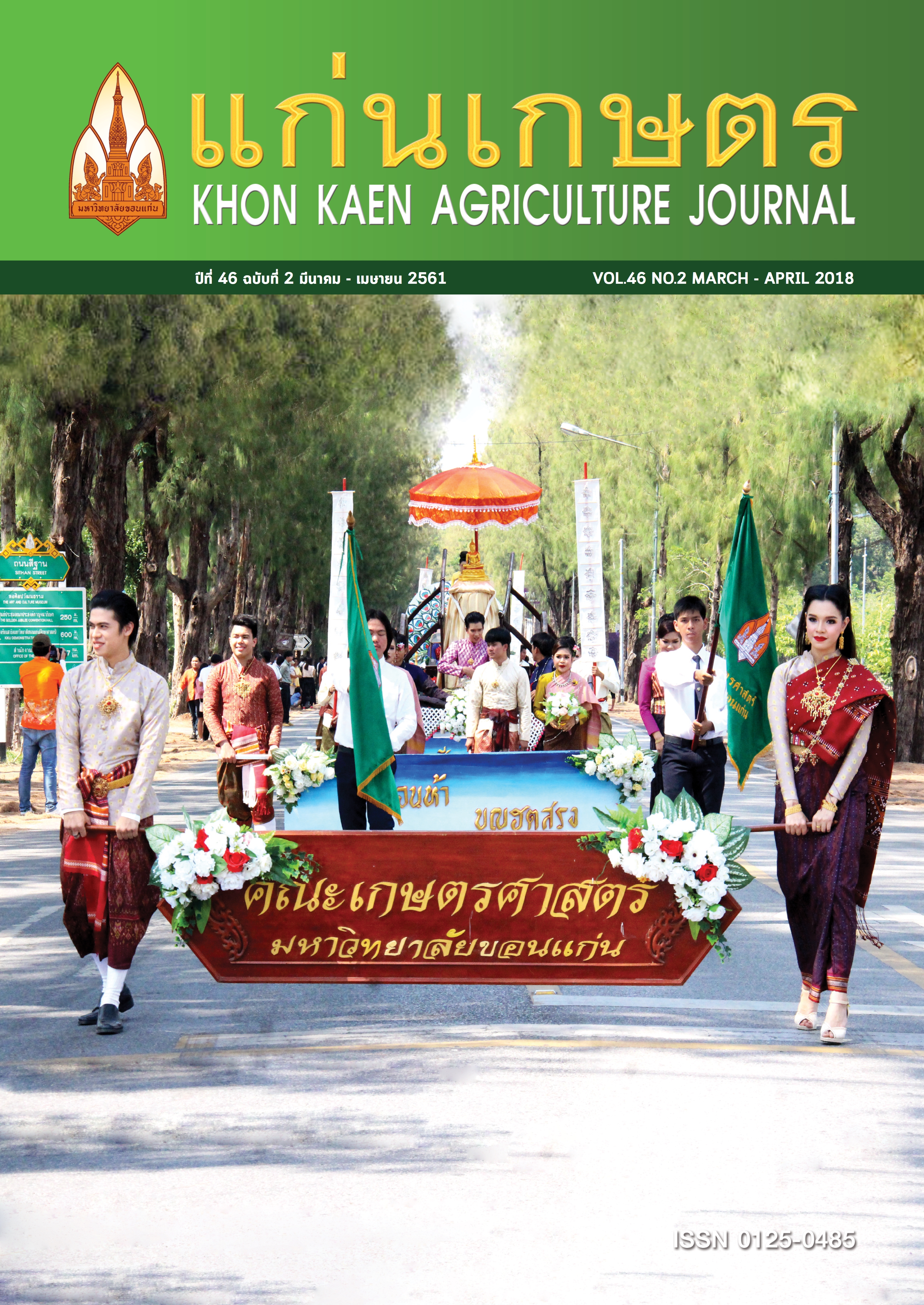ปฏิสัมพันธ์ระหว่างไส้เดือนฝอยศัตรูแมลงและแมลงหางหนีบ, Euborellia annulipes (Lucas) ในการทำลาย หนอนผีเสื้อข้าวสาร, Corcyra cephalonica (Stainton)
Main Article Content
บทคัดย่อ
การทดลองนี้ได้ศึกษาปฏิสัมพันธ์ระหว่างไส้เดือนฝอยศัตรูแมลง 3 ชนิด (Steinernema glaseri, Steinernema siamkayai และ Heterorhabditis bacteriophora) ที่มีต่อแมลงหางหนีบ (Euborellia annulipes) ในการเข้าทำลายหนอนผีเสื้อข้าวสาร (Corcyra cephalonica) ซึ่งการศึกษาความรุนแรงของไส้เดือนฝอยศัตรูแมลงในการเข้าทำลายแมลงหางหนีบ พบว่าไส้เดือนฝอยทั้ง 3 ชนิดทำให้ระยะตัวอ่อนวัย 1-5 และตัวเต็มวัยของแมลงหางหนีบตายเฉลี่ยเท่ากับ 3-20% หลังจากทดลองไป 4-7 วัน การศึกษาการเข้าทำลายของไส้เดือนฝอยศัตรูแมลงและแมลงหางหนีบที่มีต่อหนอนผีเสื้อข้าวสาร (Corcyra cephalonica) วัย 5 หลังพบการทำลายโดยคู่แข่งขันแล้ว พบว่าแมลงหางหนีบสามารถกินซากหนอนที่ติดเชื้อไส้เดือนฝอยทั้ง 3 ชนิดได้ไม่แตกต่างกับชุดควบคุม โดยมีค่าการกินเฉลี่ยอยู่ระหว่าง 40-80% ในวันที่ 7 และไส้เดือนฝอยทั้ง 3 ชนิดยังสามารถเข้าทำลายซากหนอนผีเสื้อข้าวสารที่ตายจากแมลงหางหนีบได้ 100% ในระยะเวลา 3 วัน นอกจากนั้นการศึกษาการใช้ไส้เดือนฝอยศัตรูแมลงร่วมกับแมลงหางหนีบในการควบคุมหนอนผีเสื้อข้าวสารวัยที่ 5 พบว่าไส้เดือนฝอยทั้ง 3 ชนิดเข้าทำลายหนอนผีเสื้อข้าวสารได้ไม่แตกต่างกับการใช้ไส้เดือนฝอยเพียงอย่างเดียว ซึ่งที่เวลา 3 วัน มีค่าการตายของหนอนผีเสื้อข้าวสารอยู่ระหว่าง 95-100% และแมลงหางหนีบสามารถกินหนอนผีเสื้อข้าวสารอยู่ระหว่าง 50-75% อย่างไรก็ตามไส้เดือนฝอยทั้ง 3 ชนิดเข้าทำลายแมลงหางหนีบได้ไม่เกิน 25%
Article Details
เอกสารอ้างอิง
นุชรีย์ ศิริ ทัศนีย์ แจ่มจรรยา และอโนทัย ภาระพรมราช. 2546. การควบคุมแมลงศัตรูอ้อยด้วยแมลงเบียน. น. 1-16 ใน: รายงานการวิจัยประจำปี 2546. ศูนย์วิจัยควบคุมศัตรูพืช โดยชีวินทรีย์แห่งชาติ ภาคตะวันออกเฉียงเหนือ ตอนบน.
วิวัฒน์ เสือสะอาด. 2539. แมลงศัตรูธัญพืชและพืชไร่และศัตรูธรรมชาติ. ศูนย์วิจัยควบคุมศัตรูพืชโดยชีวินทรีย์แห่งชาติ ภาคกลาง มหาวิทยาลัยเกษตรศาสตร์ วิทยาเขต กำแพงแสน จังหวัดนครปฐม. 199 หน้า.
สุอาภา ดิสถาพร. 2537. การส่งเสริมการควบคุมศัตรูพืชโดยชีววิธี. กลุ่มงานชีววิธีกองป้ องกันและกำจัดศัตรูพืช กรม ส่งเสริมการเกษตร. 131 หน้า.
Chen, Z., S. Chen, and D. W. Dickson. 2004. Nematology-Advances and Perspective. pp.1098-1099. CABI Publishing. Wallingford, UK.
Douang-Boupha, B., T. Jamjanya, W. Khlibsuwan, N. Siri, and Y. Hanboonsong. 2006. Mornitoring of insect pests, natural enemies of sweet corn and study on control methods in Khon Kaen University. Khon Kaen Agr. J. 34(1): 1-11.
Ehlers, R. U., S. Linau, O. Krasomil, and K. H. Osterfield. 1998. Liquid culture of entomopathogenic nematode bacterium complex (Heterorhabditis megidis Poinar, Jackson & Klein)/(Photorhabdus luminescence) Bio. Control. 43(1): 77-88.
Everard, A., C. T. Griffin, and A. B. Dillon. 2009. Competition and intraguild predation between the braconid parasitoid (Bracon hylobii Ratz) and the entomopathogenic nematode (Heterorhabditis downesi Stock) natural enemies of the large pine weevil (Hylobius abietis L.). 99: 151-161.
Georgis, R., H. K. Kaya, and R. Gaugler. 1991. Effect of steinemematid and heterorhabditid nematodes on non target arthropods. Environ. Entomol. 20: 815-822.
Grewal, P. S., R. U. Ehlers, and D. I. Shapiro-Ilan. 2005. Nematodes as Biocontrol Agents. CABI Publishing, Wallingford, UK.
Griffin, C. T. 2012. Perspectives on the behavior of entomopathogenic nematodes from dispersal to reproduction: traits contributing to nematode fitness and biocontrol efficacy. J. Nematol. 44(2): 177-184.
Gulcu, B., S. Hazirb, and H. K. Kaya. 2012. Scavenger deterrent factor (SDF) from symbiotic bacteria of entomopathogenic nematodes. J. Invertebr. Pathol. 110: 326-333.
Hodson, A. K., M. L. Friedman, L. N. Wu, and E. E. Lewis. 2011. European earwig (Forficula auricularia) as a novel host for the entomopathogenic nematode Steinernema carpocapsae J. Invertebr. Pathol. 107: 60–64.
Kaya, H. K. 2002. Natural enemies and other antagonists. pp.189-203. In: R. Gaugler. Entomopathogenic Nematology. CABI Publishing, UK.
Kaya, H. K., and R. Gaugler. 1993. Entomopathogenic nematodes. Ann. Rev. Entomol. 38: 181–206.
Klostermeyer, E. C. 1942. The life history and habits of the ringlegged earwig, Euborellia annulipes (Lucus) (Order Dermaptera). J. Kans. Entomol. Soc. 15(1): 13-18.
Lewis, E. E., and D. J. Clarke. 2012. Nematode parasites and entomopathogens. pp.395–424. In: F. Vega, and H. K. Kaya. Insect Pathology, 2nd Edition. Elsevier, Amsterdam, Netherlands.
Lewis, E. E., S. Hazir, A. Hodson, and B. Gulcu. 2015. Trophic relationships of entomopathogenic nematodes in agricultural habitats. pp.139–163. In: R. Campos-Herrera. Nematode Pathogenesis of Insects and Other Pests. Springer International Publishing, Switzerland.
Lordan, J., S. Alegre, G. Alins, M. J. Sarasúa, A. Morton, and F. García del Pino. 2014. Compatibility between Forficula auricularia and entomopathogenic nematodes to be used in pome fruit pest management. J. Appl. Entomol. 138: 635-643.
McCoy, C. W., D. I. Shapiro-Ilan, L. W. Duncan, and K. Nguyen. 2000. Entomopathogenic nematodes and other natural enemies as mortality factors for larvae of (Diaprepes abbreviates L.) (Coleoptera: Curculionidae) Biol. Control. 19: 182-190.
Mueller, T. F., L. H. M. Blommers, and P. J. M. Mols. 1988. Earwig (Forficula auricularia) predation onthe woolly apple aphid (Eriosoma lanigerum). Entomol. Exp. Appl. 47: 145-152.
Nonci, N. 2005. Biology and intrinsic growth rate of earwig Euborellia annulata. Indones. J. Agric. Sci. 6(2): 69-74
Noosidum, A., P. Satwong, A. Chandrapatya, and E. E. Lewis. 2016. Efficacy of Steinernema spp. plusanti-desiccants to control two serious foliage pests of vegetable crops, Spodoptera litula F. and Plutella xylostella L. Biol. Control. 97: 48-56.
Poinar Jr., G. O. 1990. Taxonomy and biology of Steinernematidae and Heterorhabditidae. pp. 23–61. In: R. Gaugler, and H. K. Kaya. Nematodes in Biological Control. CRC Press, Boca Raton, FL.
Premachandra, D. W. T. S., C. Borgemeister, O. Berndt, R. U. Ehlers, and H. M. Poehling. 2003. Combined releases of entomopathogenic nematodes and the predatory mite Hypoasis aculeifer to control soil-dwelling stages of western flower thrips Frankliniella occidentalis. Biocontrol. 48: 529–541.
R Core Team. 2016. R: A language and environment for statistical computing. R Foundation for Statistical Computing. Available: http://www.R-project.org. Accessed May 5, 2017.
Rantala, M. J., D. A. Roff, and L. M. Rantala. 2007. Forceps size and immune function in the earwig Forficula auricularia L. Biol J Linnean. Soc. 90(3): 509-516.
Riga, E., J, Whistlecraft, and J. Potter. 2001. Potential of controlling insect pests of corn using entomopathogenic nematodes. Can. J. Plant. Sci. 81: 783–787.
Rojht, H., M. Kač, and S. Trdan. 2009. Nontarget effect of entomopathogenic nematodes on larvae of two spotted lady beetle (Coleoptera: Coccinellidae) and green lacewing (Neuroptera: Chrysopidae)under laboratory conditions. J. Econ. Entomol. 102(4): 1440-1443.
San-Blas, E., and S. R. Gowen. 2008. Facultative scavenging as a survival strategy of entomopathogenic nematodes. Int. J. Parasitol. 38: 85–91.
Shapiro-Ilan, D. I., and T. E. Cottrell. 2005. Susceptibility of lady beetles (Coleoptera: Coccinellidae) to entomopathogenic nematodes. J. Invertebr. Pathol. 89: 150-156.
Situmorang, J., and B. P. Gabriel. 1988. Biology of two spesies of predatory earwigs Nala lividipes (Dufour) (Dormaptera: Labiduridae) and Euborellia annulata (Fabricius) (Dermaptera: Carconophoridae). Philipp. Entomol. 7(3): 215-238.
Tourtois, J., and M. J. Grieshop. 2015. Susceptibility of Dalotia coriaria (Kraatz) (Coleoptera: Staphylinidae) to entomopathogenic nematodes (Rhabditida: Heterorhabditidae and Steinernematidae). Insects. 6(1): 224-235.
Ulug, D., S. Hazir, H. K. Kaya, and E. Lewis. 2014Natural enemies of natural enemies: the potential top-down impact of predators on entomopathogenic nematode populations. Ecol. Entomol. 39: 462–469.
White, G. F. 1972. A method for obtaining infective nematode larvae from cultures. Science. 66(1709):302-303.
Zhou, X. S., H. K. Kaya, K. Heungens, and H. Goodrich-Blair. 2002. Response of ants to a deterrent factor(s) produced by the symbiotic bacteria of entomopathogenic nematodes. Appl. Environ. Microbiol. 68: 6202-6209.


